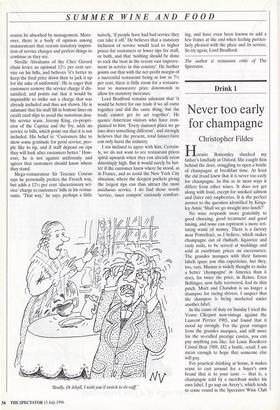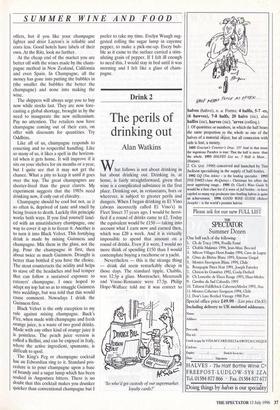Drink 1
Never too early for champagne
Christopher Fildes
Horatio Bottomley shocked my father's landlady at Oxford. She caught him behind the door, struggling to open a bottle of champagne at breakfast time. At least the old fraud knew that it is never too early for champagne. In this as in most ways it differs from other wines. It does not get along with food, except for smoked salmon and (later on) raspberries. It is the perfect answer to the question identified by Kings- ley Amis: 'Shall we go straight into lunch?'
No wine responds more gratefully to good choosing, good treatment and good timing, and none can represent a more irri- tating waste of money. There is a factory near Pontefract, so I believe, which makes champagne out of rhubarb, liquorice and rusty nails, to be served at weddings and sold at exorbitant prices on racecourses. The grandes marques with their famous labels spare you this experience, but they, too, vary. Mumm is widely thought to make a better 'champagne' in America than it does, for twice the price, in Reims. Even Bollinger, now fully recovered, had its thin patch. Moat and Chandon is no longer a shampoo for racing drivers. I suspect that the shampoo is being marketed under another label.
In the cause of duty on Sunday I tried the Veuve Clicquot non-vintage against the Laurent Perrier 1985, and found that it stood up strongly. For the great vintages from the grandes marques, and still more for the so-called prestige cuvees, you can pay anything you like: for Louis Roederer Cristal Brut 1989, £82 a bottle, retail. I am mean enough to hope that someone else will pay.
For practical drinking at home, it makes sense to cast around for a buyer's own brand that is to your taste — that is, a champagne sold by a merchant under his own label. I go nap on Avery's, which tends to come round in the Spectator Wine Club
offers, but if you like your champagne lighter and drier Layton's is reliable and costs less. Good hotels have labels of their own. At the Ritz, look no further.
At the cheap end of the market you are better off with the wines made by the cham- pagne method in New Zealand, California and even Spain. In Champagne, all the money has gone into putting the bubbles in (the smaller the bubbles the better the champagne) and none into making the wine.
The shippers will always urge you to buy now while stocks last. They are now fore- casting a global shortage, brought in by the need to inaugurate the new millennium. Pay no attention. The retailers now have champagne coming out of their ears, on offer with discounts for quantities. Try Oddbins.
Like all of us, champagne responds to cosseting and to respectful handling. Like so many of us, it likes a spell in the horizon- tal when it gets home. It will improve if it sits on your shelves for six months or a year, but I quite see that it may not get the chance. What a pity to keep it until it goes over the top. The great champagnes are shorter-lived than the great clarets. My experiment suggests that the 1985s need drinking now, if only out of chivalry.
Champagne should be cool but not, as it so often is, deprived of taste and smell by being frozen to death. Luckily this principle works both ways. If you find yourself land- ed with an unsatisfactory champagne, one way to cover it up is to freeze it. Another is to turn it into Black Velvet. This fortifying drink is made by mixing Guinness and champagne. Mix them in the glass, not the jug. Pour the champagne in first, then about twice as much Guinness. Draught is better than bottled if you have the choice. The stout counteracts the acidity and helps to stave off the headaches and bad temper that can follow a sustained exposure to caterers' champagne. I once hoped to adapt my top hat so as to smuggle Guinness into weddings, but was told that this would cause comment. Nowadays I drink the Guinness first.
Black Velvet is the only exception to my rule against mixing champagne. Buck's Fizz, when made with champagne and fresh orange juice, is a waste of two good drinks. Made with any other kind of orange juice it is pointless. The peach juice version is called a Bellini, and can be enjoyed in Italy, where the active ingredient, spumante, is difficult to spoil.
The King's Peg or champagne cocktail has an Edwardian ring to it. Standard pro- cedure is to pour champagne upon a base of brandy and a sugar lump which has been soaked in Angostura bitters. There is no doubt that this cocktail makes you drunker quicker than conventional champagne but I prefer to take my time. Evelyn Waugh sug- gested rolling the sugar lump in cayenne pepper, to make a pick-me-up. Every bub- ble as it came to the surface carried a stim- ulating grain of pepper. If I felt ill enough to need this, I would stay in bed until it was morning and I felt like a glass of cham- pagne.



































































 Previous page
Previous page